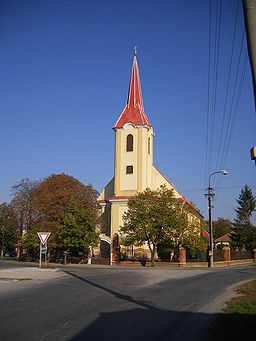Nesvady
| Nesvady | |
| Naszvad | |
| Town | |
 Catholic church in Nesvady | |
| Country | Slovakia |
|---|---|
| Region | Nitra |
| District | Komárno |
| Elevation | 114 m (374 ft) |
| Coordinates | 47°56′N 18°07′E / 47.933°N 18.117°E |
| Area | 57.86 km2 (22 sq mi) |
| Population | 5,000 (2004-12-31) |
| Density | 86 / km2 (223 / sq mi) |
| First mentioned | 1269 |
| Mayor | József Haris |
| Postal code | 946 51 |
| Area code | +421-35 |
| Car plate | KN |
  Location of Nesvady in Slovakia
| |
  Location of Nesvady in the Nitra Region
| |
| Wikimedia Commons: Nesvady | |
| Statistics: MOŠ/MIS | |
| Website: www.nesvady.sk | |
Nesvady (Hungarian: Naszvad, Hungarian pronunciation:[’nɒsvɒd]) is a village and municipality in the Komárno District in the Nitra Region of south-west Slovakia.
Geography
The village lies at an altitude of 114 metres and covers an area of 57.861 km² on the left bank of the Nitra river, around 23 km north of Komárno, 10 km north-east of Hurbanovo, and 7 km south-west of Nové Zámky. Administratively, the town belongs to the Nitra Region, Komárno District.
History
In the 9th century, the territory of Nesvady became part of the Kingdom of Hungary. In historical records the village was first mentioned in 1269. After the Austro-Hungarian army disintegrated in November 1918, Czechoslovak troops occupied the area, later acknowledged internationally by the Treaty of Trianon. Between 1938 and 1945 Nesvady once more became part of Miklós Horthy's Hungary through the First Vienna Award. In 1945, it was recovered by Czechoslovakia. A number of residents were affected by the Benes Decrees and a number of families were forced to move to Hungary in 1947. From 1945 until the Velvet Divorce, it was part of Czechoslovakia. Since then it has been part of Slovakia.
Demographics
Nesvady has a population of about 4,975 people. The ethnic make-up is about 60% Hungarian, 35% Slovak, and 5% Romany.
Facilities
The village has a public library, a gym and a football pitch.